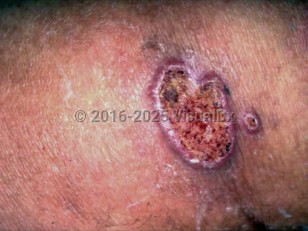Paracoccidioidomycosis
Alerts and Notices
Important News & Links
Synopsis

Paracoccidioidomycosis, also known as South American blastomycosis, Lutz mycosis, Brazilian blastomycosis, and paracoccidioidal granuloma, is a deep fungal infection caused by the dimorphic fungus Paracoccidioides brasiliensis. It is most commonly found in males living in rural and agricultural areas of Mexico, Central America, and South America, especially Brazil.
The fungus normally is found in soil and is acquired by inhalation. Rarely, it is acquired by direct inoculation into the skin or mucosa from infected plant matter. The disease can manifest in 4 clinical forms: pulmonary, mucocutaneous, lymphatic, and mixed.
Pulmonary infection is the most common and is found in 70%-80% of patients. Disease is localized to the lung in 25% of cases. This is followed by dissemination to the skin and mucosa (around the pharynx, the mouth, and occasionally the anus), lymphatic system (especially cervical nodes), adrenal glands, liver, spleen, central nervous system (brain lesions [abscess, granuloma, nodule, or cyst] or less commonly meningitis), and bones. The clinical course is usually chronic and progressive over months to years, with associated weight loss and chronic cough.
In travelers to endemic areas, the mean time to presentation was 15 years, suggesting a long dormancy before disease presentation.
The fungus normally is found in soil and is acquired by inhalation. Rarely, it is acquired by direct inoculation into the skin or mucosa from infected plant matter. The disease can manifest in 4 clinical forms: pulmonary, mucocutaneous, lymphatic, and mixed.
Pulmonary infection is the most common and is found in 70%-80% of patients. Disease is localized to the lung in 25% of cases. This is followed by dissemination to the skin and mucosa (around the pharynx, the mouth, and occasionally the anus), lymphatic system (especially cervical nodes), adrenal glands, liver, spleen, central nervous system (brain lesions [abscess, granuloma, nodule, or cyst] or less commonly meningitis), and bones. The clinical course is usually chronic and progressive over months to years, with associated weight loss and chronic cough.
In travelers to endemic areas, the mean time to presentation was 15 years, suggesting a long dormancy before disease presentation.
Codes
ICD10CM:
B41.9 – Paracoccidioidomycosis, unspecified
SNOMEDCT:
59925007 – Paracoccidioidomycosis
B41.9 – Paracoccidioidomycosis, unspecified
SNOMEDCT:
59925007 – Paracoccidioidomycosis
Look For
Subscription Required
Diagnostic Pearls
Subscription Required
Differential Diagnosis & Pitfalls

To perform a comparison, select diagnoses from the classic differential
Subscription Required
Best Tests
Subscription Required
Management Pearls
Subscription Required
Therapy
Subscription Required
References
Subscription Required
Last Updated:09/06/2017
Paracoccidioidomycosis

